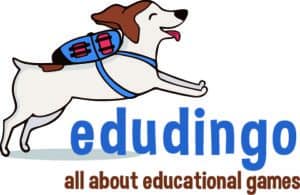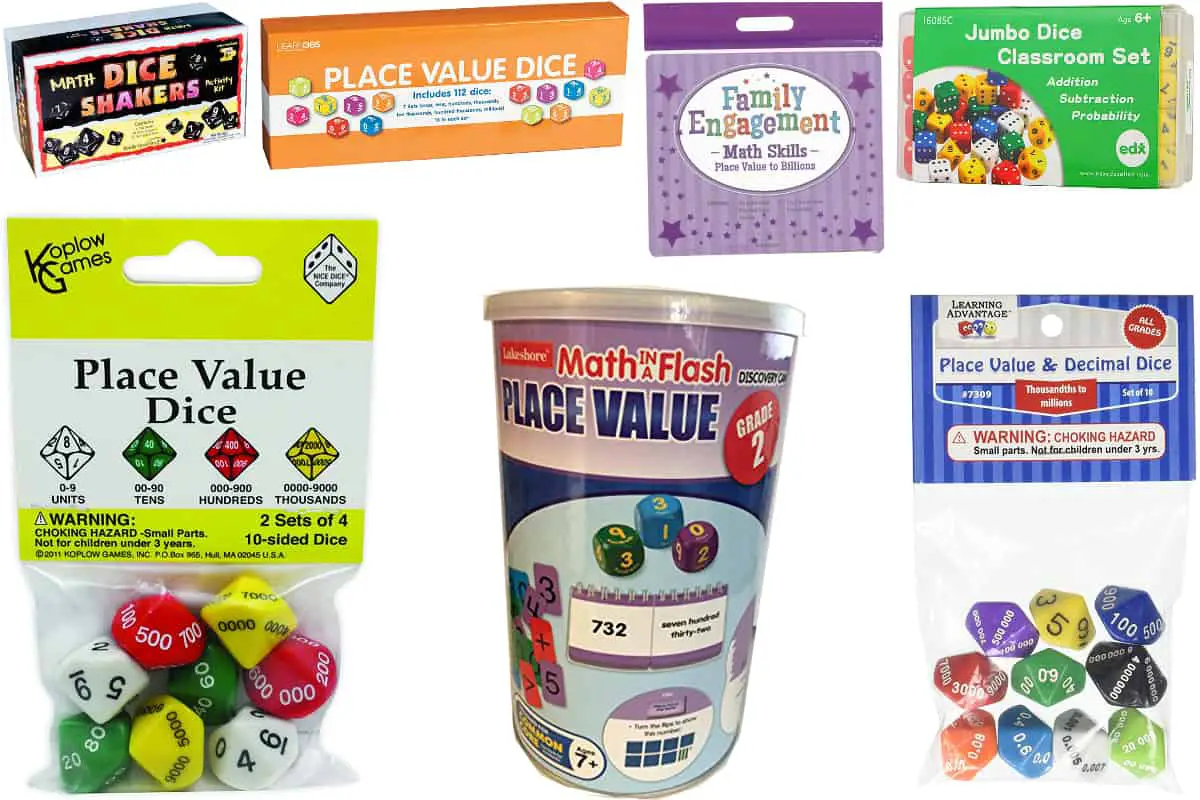This post contains affiliate links.
Using dice to teach place value is a terrific idea, as you can use a die for each power of ten (ones, tens, hundreds, etc…) to generate any number you want by a throw of dice… and children love throwing dice anyway.
So I made a comprehensive list of place value dice sets, divided into 3 sections:
- Activity Kits
- Whole number Dice Sets, for example, Jumbo Place Value Dice Set
- Decimal Number Dice Sets
I also included a section with two Books about Place Value Dice Games that will enable you to make the most of your dice sets!
Type of Place Value Dice
Powers of ten (digit position) can be represented (for example in the number “374”) as:
- Names: “4 ones”, “7 tens”, “3 hundreds”… insisting on powers of ten by giving their name (hundreds, tens…). It is OK but I prefer the next approach:
- Numbers: “4”, “70”, “300”: Seeing the number of zeroes facilitates remembering the positions of the digits in the number. But millions (3 000 000) are hard to fit a die face (although it works).
- None: no indication of digit position on the dice, and instead fitting dice in transparent placeholders for ones, tens…
Most of the time, each “power of ten” die has a specific color, which I find much better than having all dice of the same color.
There are also two types of dice:
- Cubic “6 faced” dice: though certaily cheaper to produce, they have the drawback of skipping some of the 10 digit values (from 0 to 9)
- 10-faced dice are much better, as you can draw any number with them
Dice Games Comparison Table
The place value dice sets in this list are useful in introducing place value concepts from Grade 1 to 6. Here is a quick guide for you to check out the age range.
| Game | Type | Age | Players | For | Dice digit | Dice color | Dice faces | Numbers | Rating |
|---|---|---|---|---|---|---|---|---|---|
| Place Value Instant Learning Center | Activity kit | 6‑8 | 1-4 | Teachers | Name | Red | 6 | 000 999 | ★★★☆☆ |
| Place Value Discovery Can | Activity kit | 7‑9 | 1-2 | Families, Teachers | Name | Per digit | 6 | 000 999 | ★★★☆☆ |
| Family Engagement Math skills | Activity kit | 8‑11 | 1-2 | Families, Teachers | Number | Per digit | 10 | 0,000,000.0 9,999,999.9 | ★★★★☆ |
| Dice Shakers Math Kit | Activity kit | 8‑11 | 2-4 | Teachers | Placeholder | Black | 10 | 0000 9999 | ★★★☆☆ |
| Place Value Dice (Oriental Trading) | Dice set | 7‑11 | 2-7 | Teachers | Name | Per digit | 6 | 0000000 9999999 | ★★★☆☆ |
| Place Value Dice (Didax) | Dice Set | 7‑11 | 1-2 | Families, Teachers | Number | Per digit | 10 | 0000 9999 | ★★★☆☆ |
| Place Value Dice (Koplow Games) | Dice Set | 7‑11 | 1-2 | Families, Teachers | Number | Per digit | 10 | 0000 9999 | ★★★☆☆ |
| Place Value and Decimal Dice | Dice Set | 7‑11 | 1-2 | Teachers | Number | Per digit | 10 | 0 000 000.000 9 999 999.999 | ★★★★★ |
| Place Value Jumbo | Dice Set | 6‑11 | 1-2 | Teachers | Number | Per digit | 10 | 000 000 999 999 | ★★★★☆ |
| Place Value Dice (Modern Teaching Aids) | Dice Set | 6‑8 | 1-2 | Teachers | Name | Per digit | 10 | 000 999 | ★★★★☆ |
| Jumbo Place Value Dice Set (EdxEducation) | Dice Set | 6‑11 | 1-4 | Teachers | Number | Per digit | 10 | 0000 9999 | ★★★☆☆ |
Place Value Dice Activity Kits
These 4 dice kits include a step-by-step approach and instructions on how to study place value concepts through different activities.
Place Value Instant Learning Center (Lakeshore Learning)

★★★☆☆
For Teachers | Age: 6-8 | 1-4 Students | Price $$$
Place Value Instant Learning Center contains skill-building activities that teach place values with 3-digit numbers using:
contains skill-building activities that teach place values with 3-digit numbers using:
- 12 red foam numbered dice
- 4 erasable mats
- 4 write and wipe markers
- double-sided instruction chart
- Activity guide
This activity can be played by 4 players simultaneously. Each mat contains three sets of instructions.
- The first activity requires the player to roll the dice and write the number on the boxes provided on the mat (There are six boxes).
- The second activity requests the player to write the greatest and the smallest number among the set of numbers in the first activity. (There are two boxes, labeled greatest and smallest)
- The third activity asks the player to write the numbers in the second activity in expanded form. (For example, the greatest number is 388, they will write 300+ 80+8 inside the boxes)
I like this activity set because
- It teaches place values in progression (children will not get bored easily, rolling the dice is fun)
- Teachers can track the progress of each child using a reproducible assessment card.
- The materials are well-made and easy to use.
I recommend this set to 7–8-year-old children because this activity set reinforces children’s understanding of hundreds, tens, and ones through writing.
Place Value Discovery Can (Lakeshore Learning)

★★★☆☆
For Teachers, Families | Age: 7-9 | 1-2 Students | Price $$$
In Place Value Discovery Can , players solve place value word problems using multiple objects.
, players solve place value word problems using multiple objects.
At first, this activity is challenging for 7–9-year-old children because it requires reading and comprehension of the problem in order to do the activity on each card.
This set has 25 round-shaped activity cards. Each card contains an instruction that would require the use of either:
- 3 cubes (dice numbered 0-9)
- manipulatives (card pieces with numbers and signs which include addition, equal, greater than and less than)
- Flip book
I like the variety of activities that this activity set offers because they are not limited to
- identifying place values
- Creating numbers with number cubes
- building numbers in expanded form
- Comparing numbers through base 10 blocks
7–9-year-old children can explore learning place values up to three digits with various problem-solving and tactile activities.
Dice Shakers Math Kit (Really Good Stuff)
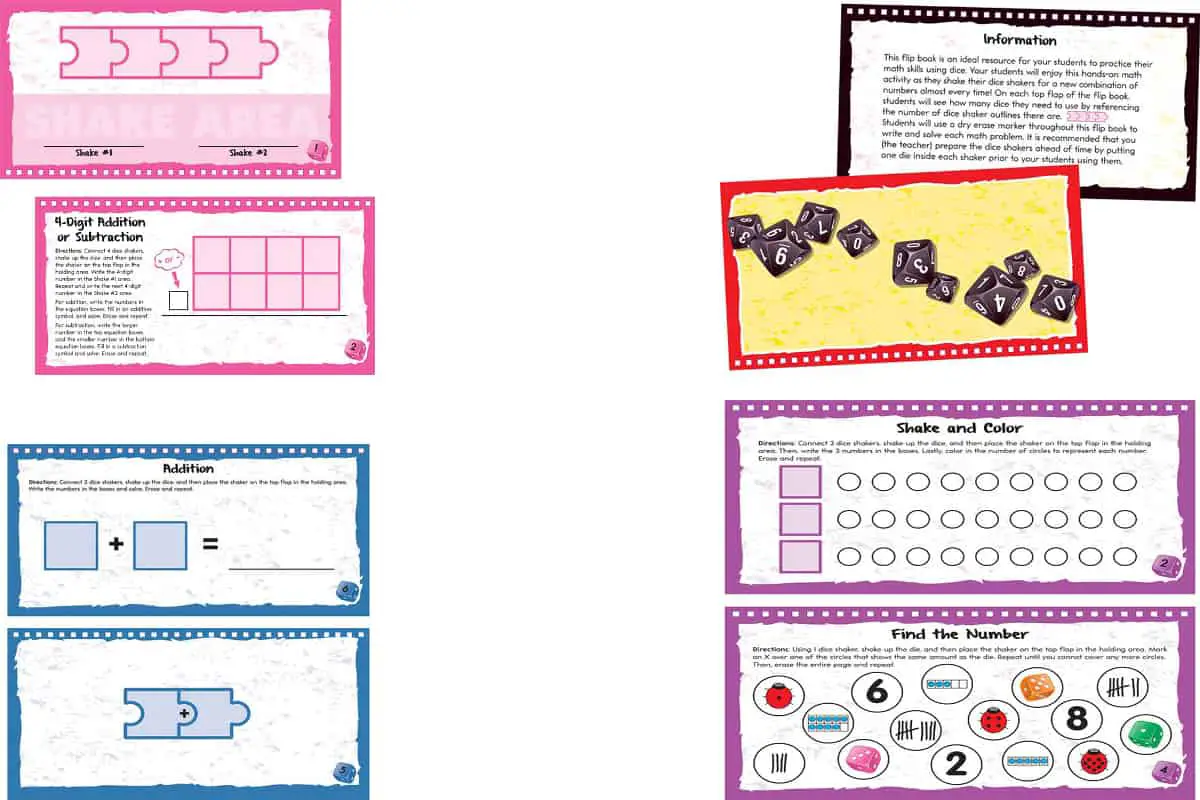
★★★☆☆
For Teachers | Age: 7-9 | 2-4 students | Price $$$$
In Dice Shakers Math Kit , students solve a variety of math problems that are good for grade 3-5 level.
, students solve a variety of math problems that are good for grade 3-5 level.
The kit includes:
- 4 flip books
- 16 ten-sided dice
- 16 dice shakers
Although its flipbook has only four pages dedicated to place value activities, it is a nice tool to place value math drills in class.
I recommend this kit to 7–9-year-old children because the instructions are unique but easy to follow. Children can also do the activities at home without adult supervision.
Family Engagement Math Skills- Place Value to Billions (Really Good Stuff)
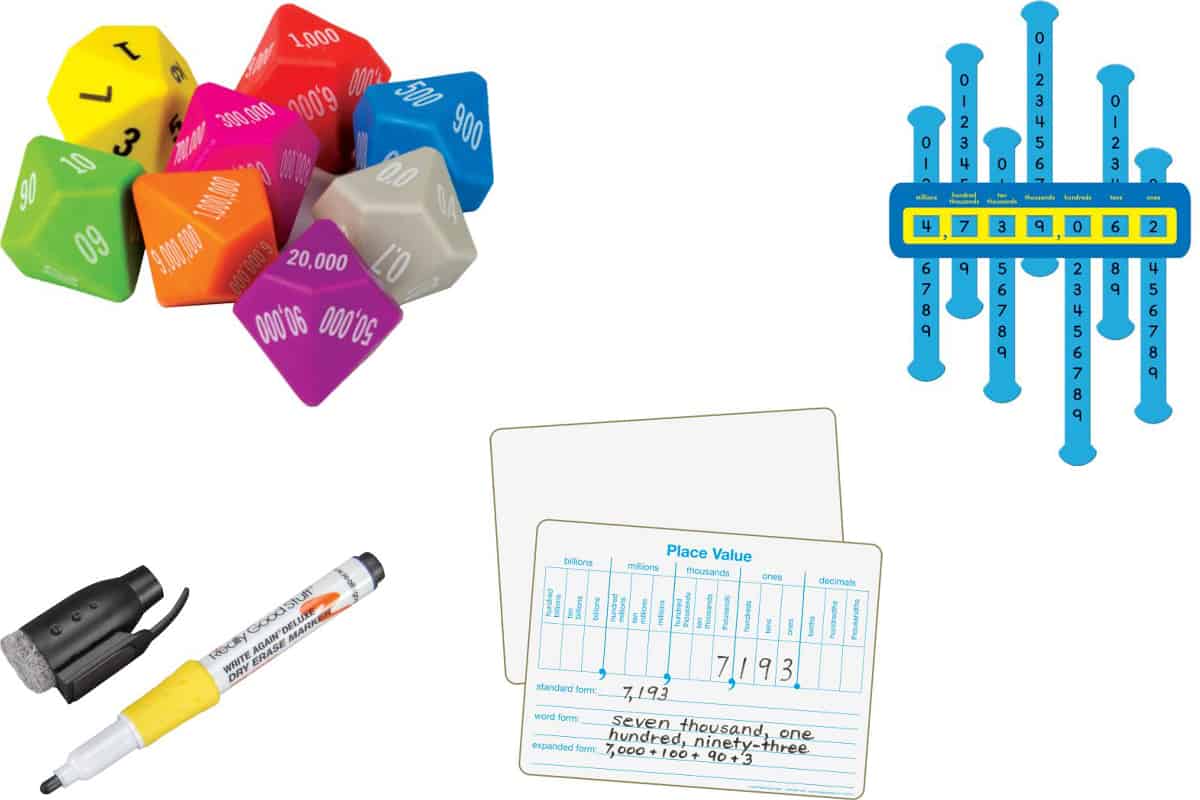
★★★★☆
For Teachers & Families | Age: 8-11 | 1-2 Students | Price $$$
Family Engagement Math Skills provides several place value activities using
provides several place value activities using
- 8 sets of colorful dice
- Slidable number lines
- Erasable board & 2 markers
- Place value activity mat
The activities include
- Building numbers by rolling the dice
- Identifying place values in number lines
- Locating place values and decimals by writing numbers on erasable practice mats
- Improving number sense by writing numbers in three ways: digit form, word form and expanded form.
I recommend this set for 8–11-year-old children because they can practice place value up to:
- 15 digits in writing (including decimals with tenths, hundredths and thousandths)
- 8 digits with dice (including decimals with tenths)
Place Value Dice Sets
In this section, I would like to share several dice sets that are available for place value practice.
They do not come with rules, but you can use rules proposed by the two books recommended in the following section.
Place Value Dice (Oriental Trading)
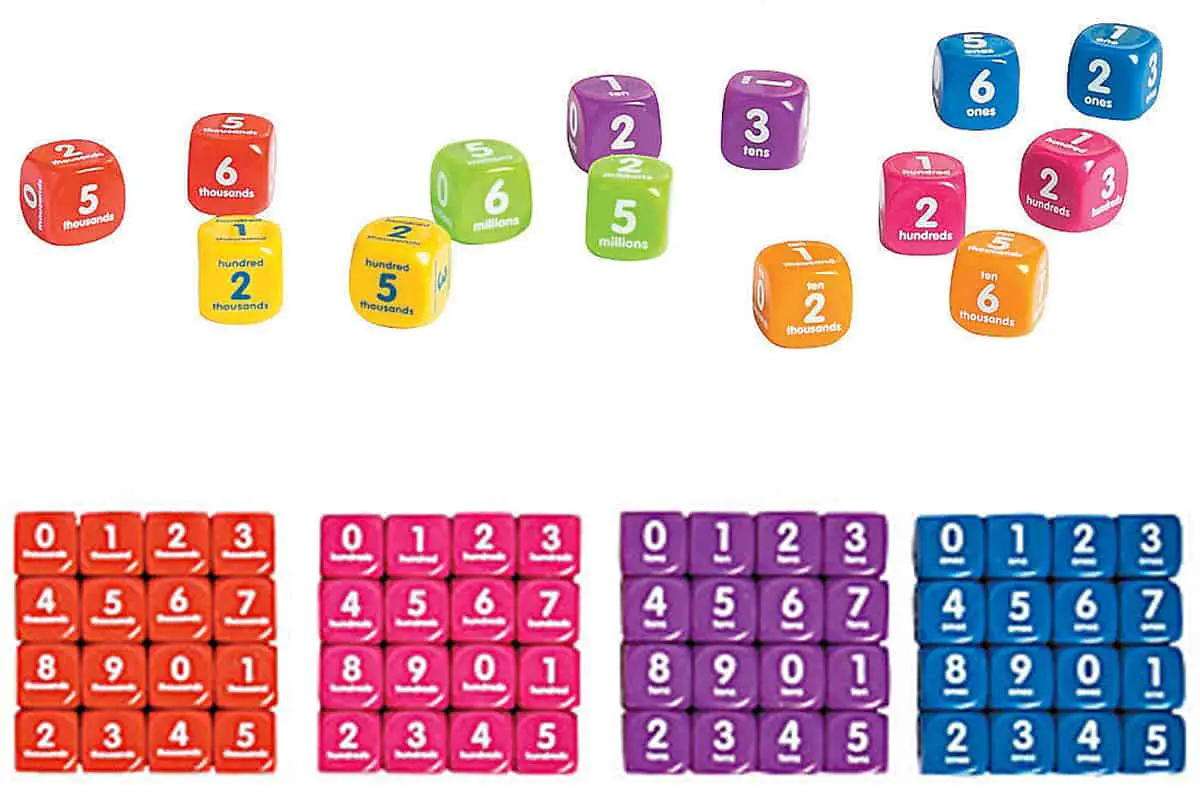
★★★☆☆
For Teachers | Age: 7-11 | 2-7 Students | Price $$$
Place Value Dice helps students from Gr.2-5 understand place values up to 7 digits.
helps students from Gr.2-5 understand place values up to 7 digits.
It consists of 7 sets of multicolored numbered dice (0 to 9 thanks to having several nonidentical dice for the same digit) that are labeled from ones to millions (112 pieces in total).
Each face of the dice displays the place value in word form (for example, 5 tens, 7 millions).
Also, it uses the following color-coding format:
- Blue for ones
- Purple for tens
- Pink for hundreds
- Red for thousands
- Orange for ten thousands
- Yellow for hundred thousands
- Yellow green for millions
Place Value Dice (Didax)
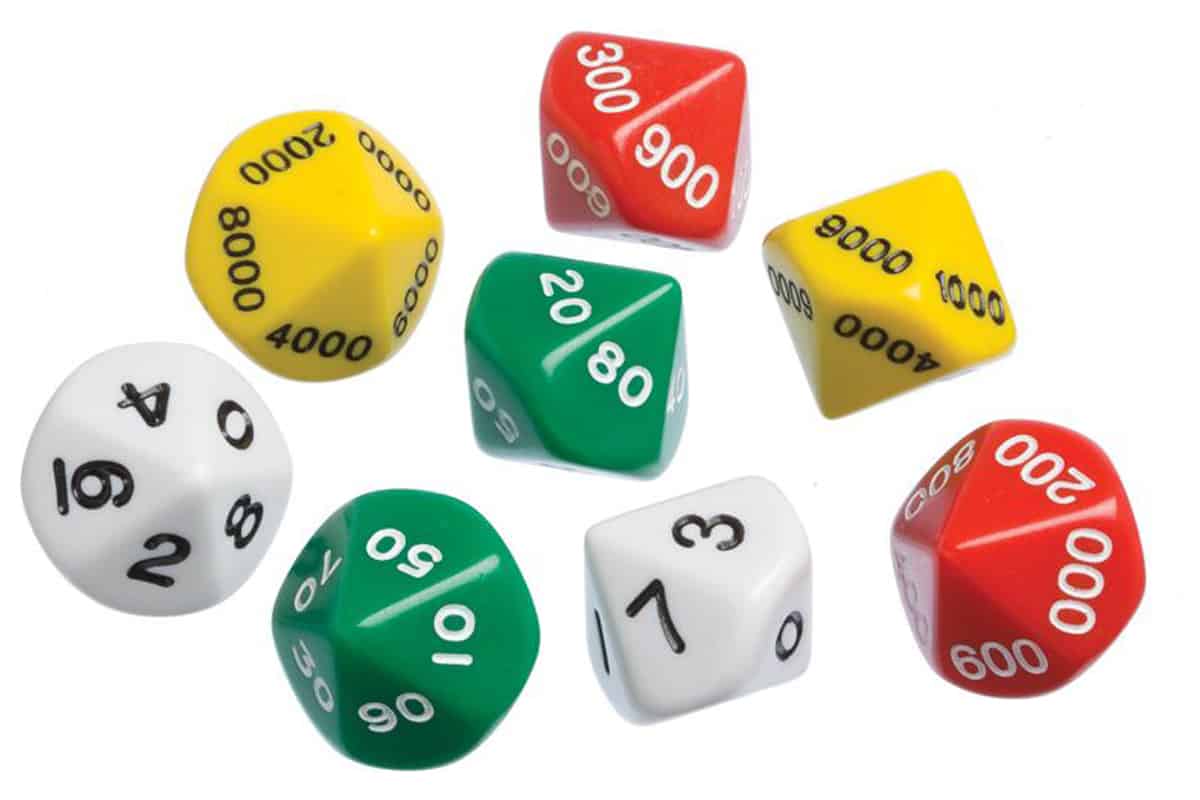
★★★☆☆
For Teachers & Families | Age: 7-11 | 1-2 Students | Price $$
Place Value Dice consists of 8 pieces of 10-sided color-coded dice representing ones, tens, hundreds, and thousands:
consists of 8 pieces of 10-sided color-coded dice representing ones, tens, hundreds, and thousands:
- 0-9 (ones – white)
- 00-90 (tens – green)
- 000-900 (hundreds – red)
- 0000-9000 (thousands – yellow)
Place Value Dice (Koplow Games)

★★★☆☆
For Teachers & Families | Age: 8-11 | 1-2 Students | Price $$
Another dice set that can be used as a classroom tool is Koplow’s Place Value Dice , which is almost identical to the set from Didax (same numbers, colors, number of dice).
, which is almost identical to the set from Didax (same numbers, colors, number of dice).
Place Value Jumbo (Modern Teaching Aids)

★★★★☆
For Teachers | Age: 6-11 | 1-2 Players | Price $$
Place Value Jumbo presents six color-coded dice (for digit position up to 6 digits) that are larger than typical dice sets.
presents six color-coded dice (for digit position up to 6 digits) that are larger than typical dice sets.
That is why I recommend this set to children from grade 1 to 4 or 6–11-year-old children.
Place Value Dice (Modern Teaching Aids)
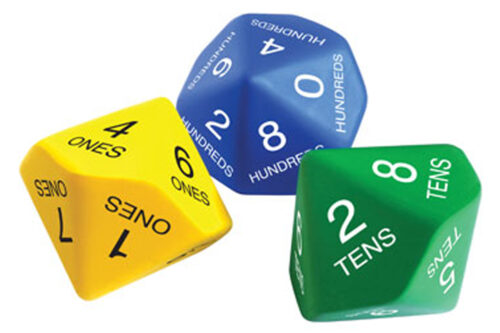
★★★★☆
For Teachers | Age: 6-8 | 1-2 Players | Price $$
Place Value Dice enables children from grades 1-2 to study place values with 3 digits.
enables children from grades 1-2 to study place values with 3 digits.
Digit position is indicated by the die color, and the name (“ones”, “tens”, “hundreds”).
The dice are made in polyurethane, making them more silent, which is great for the classroom.
Jumbo Place Value Dice Set (Edx Education)
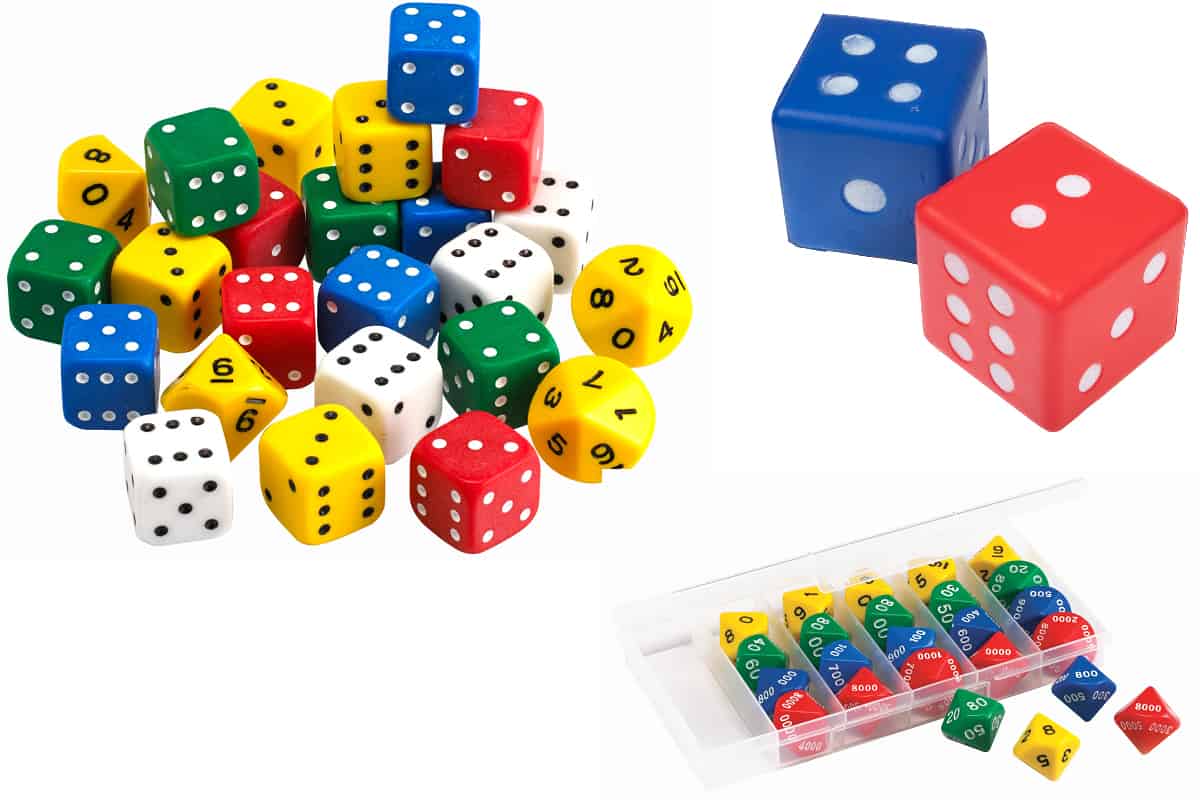
★★★☆☆
For Teachers | Age: 7-9 | 1-4 Players | Price $$
Jumbo Place Value Dice Set aids children from Grade 1-3 to learn place values with 4 digits.
aids children from Grade 1-3 to learn place values with 4 digits.
It contains 6 sets of 4 color-coded dice which measures 34 mm each. (There are 24 pieces of 10-sided plastic dice in total)
Its color-coding format is as follows:
- Yellow for ones (0-9)
- Green for tens (00-90)
- Blue for hundreds (000- 900)
- Red for thousands (0 000- 9 000)
I recommend this dice set for 6–9-year-old children because the pieces are more recognizable due to size and color.
Dice Sets for Place Values and Decimals
In this section, I would like to share 2 dice sets that are good for studying place values for whole numbers and decimals.
Place Value and Decimal Dice (Learning Advantage)
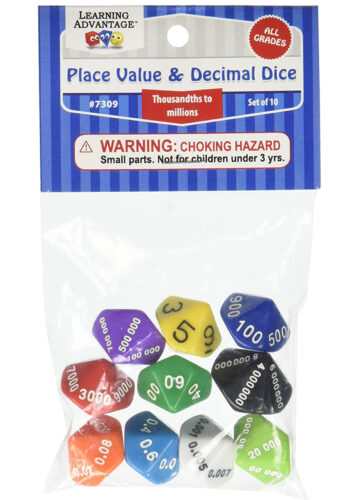
★★★★★
For Teachers | Age: 7-11 | 1-2 Players | Price $$$
Place Value and Decimal Dice is another iteration of Place Value Dice from Learning Advantage.
is another iteration of Place Value Dice from Learning Advantage.
Similarly, it consists of 12 acrylic 10-sided dice but comes in different colors.
- Yellow for ones (0-9)
- Green for tens (00-90)
- Royal Blue for hundreds (000-900)
- Red for thousands ( 0 000- 9 000)
- Yellow Green for ten thousands (00 000- 90 000)
- Purple for hundred thousands ( 000 000- 900 000)
- Black for millions (0 000 000- 9 000 000)
For decimals place,
- Sky blue for tenths (0.0 -0.9)
- Orange for hundredths (0.00 – 0.09)
- White for thousandths (0.000 – 0.009)
I recommend this set to 7–11-year-old children because this learning tool will help them understand place values for whole numbers up to millions and decimals up to thousandths place.
They can also be ordered by sets of 12 identical dice Place Value Dice (per digit position). This makes great sense to equip your classroom (you can have up to 12 groups of students playing together!).
(per digit position). This makes great sense to equip your classroom (you can have up to 12 groups of students playing together!).
Place Value Per Grade Level
I made a quick reference of what kind of place value work do children face at each level.
| Grade | Place Value Competencies according to CCSS |
| 1 | Count, read, and write numbers to 100 in digit form Recognize place value beyond 20 through pictorial representation |
| 2 | Identify the place value of each digit in a two-digit number (tens and ones) |
| 3 | Identify the place value of each digit in a three-digit number (hundreds, tens, and ones) |
| 4 | Identify the place value of each digit in a four-digit number (thousands, hundreds, tens, and ones) Introduce place values in decimals |
| 5 | Determine the value of each digit up to millions |
| 6 | Distinguish the value of each digit up to ten millions |
Two Books About Place Value Dice Games
Dice Games for Place Value contains easy to follow dice games that help students learn math concepts, including:
contains easy to follow dice games that help students learn math concepts, including:
- Counting in multiples from a starting point
- Rounding decimals to the nearest tenth or whole number
- Developing place value understanding
- Mastering basic operations (addition, subtraction, multiplication and division)
The activities are good for students from Grade 2-7 or 7-13 years old.
This collection of practice activities was made by Dr. Paul Swan who has authored more than 50 books about mathematics.
Kim Sutton’s Dynamic Dice is also a good reference for highly motivating and easy-to-implement games and activities that focus on math skills for students from kindergarten to Grade 5. The topics cover basic facts, place value, fractions and decimals, number sense, rounding, factoring, and many more.
is also a good reference for highly motivating and easy-to-implement games and activities that focus on math skills for students from kindergarten to Grade 5. The topics cover basic facts, place value, fractions and decimals, number sense, rounding, factoring, and many more.
This book is dedicated to explaining how to use three kinds of dice effectively. In fact, the games are well categorized according to these types of dice:
- Double dice
- Ten-sided or decahedron double dice
- Place Value Dice
Lastly, the games and activities are designed to be enjoyed repeatedly for maximum retention. They can be played by the whole class or small groups.
Other Types of Place Value Games
If you are interested in more place value games, you might want to check the following posts:
- 11 Place Value Card Games and Flashcards for Schools and Families

- 12 Place Value Board Games for Schools and Families

- 6 Place Value Puzzles for Children from Kindergarten to Grade 2
- 24 Place Value Manipulatives with Cubes, Blocks and Disks
Edudingo.com is a participant in the Amazon Services LLC Associates Program, an affiliate advertising program designed to provide a means for sites to earn advertising fees by advertising and linking to Amazon.com. We also participate in other affiliate programs which compensate us for referring traffic.
